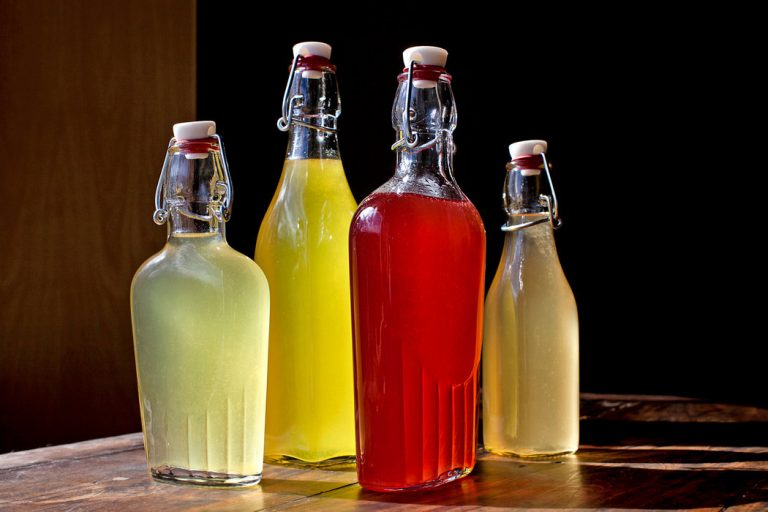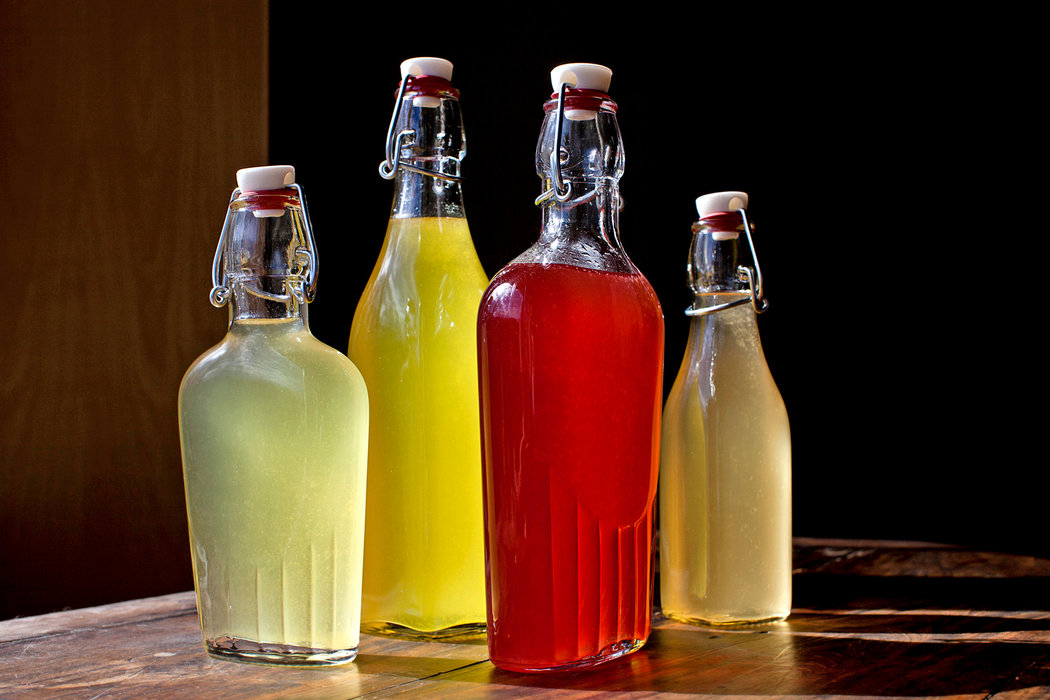Judy Bart Kancigor, OUcooking.org Columnist – Melting Pot Memories says:
 CHERRY VISHNYEK
CHERRY VISHNYEK
My grandfather, Papa Harry, used to make a cordial with the sour cherries from his cherry trees. When my Aunt Estelle was three years old, she uncorked the bottle when no one was looking and helped herself to the cherries. Fortunately they soon found her wobbling around, and except for her first hangover, no harm was done.
I included this recipe, which I adapted from one in Yiddish Cuisine: A Gourmet’s Approach to Jewish Cooking by Robert Sternberg, in my cookbook, “Cooking Jewish.” It’s probably pretty close to Papa Harry’s, although my Aunt Sally said he didn’t measure any more accurately than Mama Hinda did in her cooking and baking. (Vishnyek is distinguished from Slivovitz, which is made from plums.)
- 1 lb. sour cherries, pitted and cut in half
- 2 1/2 cups sugar
- 1 liter vodka
- Place the cherries in a large glass canning jug with a clamp-seal top. Add the sugar, and then pour in the vodka. Clamp the lid of the jug, and shake it vigorously to dissolve the sugar. Place the jug in a cool, dark place and allow it to ferment for at least 6 to 8 weeks, shaking the jar once a day.
- Uncover the jar and, through a funnel lined with cheesecloth, strain the liqueur into a decanter. Cork or cover the decanter, and serve the liqueur as you would any liqueur or cordial: on special occasions, or as an after-dinner drink, or as a palate cleanser after the fish course.
Norene Gilletz, OUcooking.org Columnist – The Flavor of Memory says:
I’m not a big drinker and most of my friends and family know that my favorite wine is “Do I have to do the dishes?” However, I love coffee liqueur, especially when it’s drizzled over crushed ice and topped with milk – or even whizzed together in a blender to make a wonderful coffee smoothie (but it’s not for children)!
Here are two luscious homemade liqueur recipes for you to enjoy which were kindly shared with me by author A. J. Rathbun of Seattle, WA. Pomegranate Liqueur would be wonderful to serve for the upcoming High Holidays, when pomegranates are plentiful.
[Excerpted from Luscious Liqueurs, by A.J. Rathbun. (c) 2008, used by permission from The Harvard Common Press.]
PERSEPHONIA (Pomegranate Liqueur)
Makes about 1 1/2 pints
- 2 pomegranates
- 1 Tablespoon freshly-grated orange zest
- 1/2 teaspoon ground cinnamon
- 2 cups vodka
- 1/2 cup Simple Syrup (below)
- Remove the seeds from the pomegranates using a spoon or any other process you think works best. Put the seeds in a bowl and, using a muddler or wooden spoon, crush them to release the juice.
- Put the juice and seed bits, orange zest, cinnamon, and vodka in a glass container with a tight-fitting lid. Seal and place the container in a cool, dry, place away from sunlight. Let sit for 2 weeks, swirling occasionally.
- Add the simple syrup, stir, and reseal. Return to its spot. Let sit for 2 more weeks.
- Carefully strain the liqueur through a double layer of cheesecloth into a pitcher or other easy-pouring vessel. Strain again through 2 new layers of cheesecloth into another pitcher or bottle. Check that the liqueur is free of debris (the little seed particles can slip through). If it isn’t, repeat this step until it is. Pour the liqueur into 1 large bottle or a number of small bottles or jars.
A Cocktail Suggestion: If the sun’s shining bright, try pouring 1 1/2 ounces over ice in a highball glass. Top with club soda (if you’re not feeling sweet) or 7 UP (if you are, a little).
Simple Syrup:
- 2 1/2 cups water
- 3 cups sugar
- Combine the sugar and water in a medium-size saucepan. Stirring occasionally, bring the mixture to a boil over medium-high heat. Lower the heat a bit, and keep the mixture at a low boil for 5 minutes.
Store in a clean glass jar in the refrigerator for up to a month.
COFFEE LIQUEUR
Makes about 3 pints
- 1/4 cup instant espresso powder
- 2-1/2 cups light brown sugar
- 1 cup water
- 1/4 cup whole coffee beans of your choice
- 3 cups brandy
- 1 teaspoon pure vanilla extract
- Combine the instant espresso, sugar, and water in a medium-size saucepan over medium-high heat. Stirring occasionally, bring the mixture almost to a boil. Lower the heat a bit, keeping the mixture at a low simmer for 5 minutes. Turn off the heat, and let the syrup cool completely in the pan.
- Put the syrup, coffee beans, and brandy in a glass container with a tight-fitting lid. Stir well. Seal and place the container in a cool, dry spot away from sunlight. Let sit for 2 weeks, swirling occasionally.
- Add the vanilla, stir again, and reseal. Return to its spot. Let sit for 2 more weeks.
- Carefully strain the liqueur through a double layer of cheesecloth into a pitcher or other easy-pouring vessel. Strain again through 2 new layers of cheesecloth into 1 large bottle or a number of small bottles or jars.
A Cocktail Suggestion: For a knockout Black Russian, pour 1 1/2 ounces Coffee Liqueur and 2 ounces vodka over ice in an old-fashioned glass. Stir a couple of times and you’ll be dreaming of Moscow.
Faye Levy, OUcooking.org Columnist – Food by Faye says:
When I studied cooking in at Ecole de Cuisine La Varenne in Paris, we made fruit liqueur from brandied cherries. We added cherries and sugar to brandy, and they turned the brandy into tasty fruit liqueur.
According to Anne Willan, founder of Ecole de Cuisine La Varenne, “French markets sell neutral spirits for conserving fruits in alcohol, but vodka also works well.” (“Chateau Cuisine” by Anne Willan.)
Here is the recipe for brandied cherries that we used. It appears in “French Regional Cooking” by Anne Willan and Ecole de Cuisine La Varenne, Paris. I enjoyed very much working with Anne on this book, as the recipe researcher and editor.
BRANDIED CHERRIES
In fruit-growing areas like the Alps and the Vosges, preserving with eau-de-vie (clear fruit brandy) is standard practice. Firm fruits like cherries, apricots and peaches do best and they are always packed in a glass jar as their appearance is half their appeal. In general these brandied fruits act as a “digestif” at the end of dinner, with one or two fruits served in each little glass of brandy. Brandied fruits are also excellent, if less traditional, spooned over vanilla ice cream.
- 2 lbs. slightly tart cherries
- 8 oz. sugar
- 1 quart eau de vie or plain brandy
- Wash the cherries and cut off half of each stem. Pat them dry and put them into three sterilized 1-quart jars that have tight-fitting covers. Put the sugar in a large bowl, add the brandy and leave 10-15 minutes until the sugar has dissolved, stirring occasionally. Pour enough of the solution over the cherries to cover them. Seal tightly and store the cherries for 2 months or more before eating them.
Serves 10.
BLACK CURRANT LIQUEUR – CREME DE CASSIS
This recipe is from a Jane Sigal, friend of mine who also worked with me at La Varenne and later became an editor at Food and Wine Magazine. The recipe is in her book, “Backroad Bistros, Farmhouse Fare.”
Almost any tart berry can be substituted her, for example blackberries or elderberries. You may need to adjust the sugar to the sweetness of the fruit. Whatever the berry, this liqueur is good poured over a fruit mousse, a simple cake or crepes, as well as with ice cream and poached fruit. Try it, too, to make kir.
- 1/2 lb. fresh black currants
- 1 cup fruity red wine, preferably a young Burgundy
- 1 cup granulated sugar
- 1/3 cup brandy
- Discard the small stems from the berries. Put the berries in a bowl and crush them slightly with a fork. Pour in the wine and steep the berries, covered, for 2 days. (You do not need to chill the mixture.)
- Pour the berries with the wine through a fine strainer into a measuring cup, pressing on the berries to extract all the juice. There should be about 1 cup of liquid.
- Pour the wine into a saucepan and add the sugar. Heat gently, stirring, until the sugar dissolves, then simmer until it thickens and becomes syrupy, 3 to 4 minutes.
- Let the liqueur cool and stir in the brandy. Seal tightly in a bottle and store at room temperature for up to a month. The flavor improves with time.
- Makes about 1 cup.

